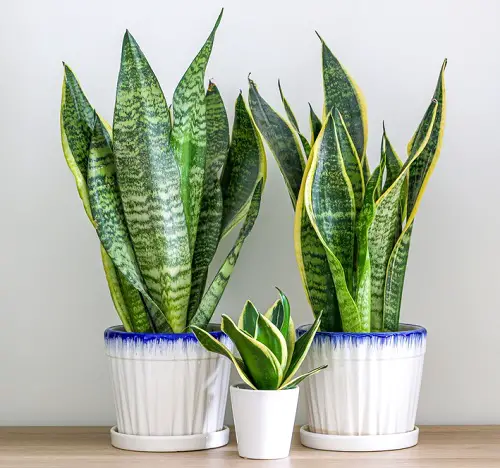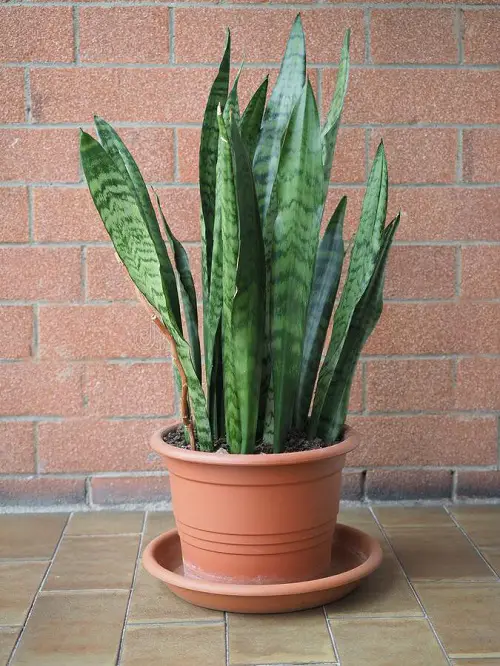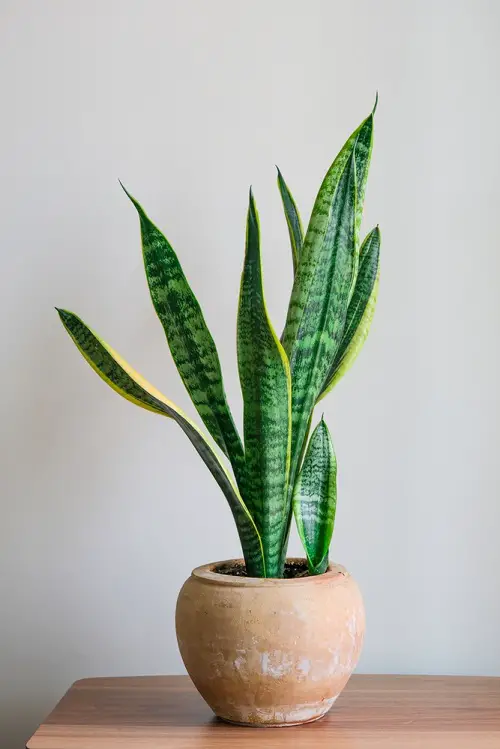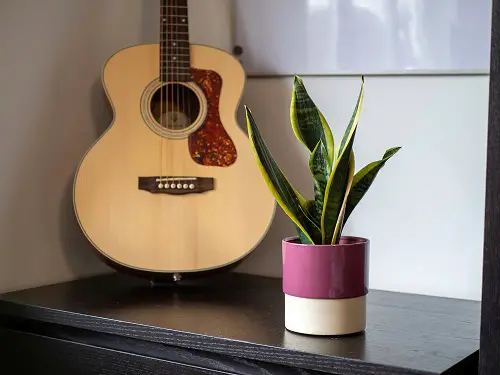Have a look at our comprehensive guide on the Best Pots for Snake Plants and upgrade your plant’s home today.
Choosing a pot for a snake plant is not as easy as it seems. But it’s not rocket science either. You just need to be attentive to the plant’s needs. Here’s how to select the Best Pots for Snake Plants.
Choosing the Best Pots for Snake Plants
There are many things you need to check for when choosing a snake plant pot.
- Drainage: Snake plants need well-draining soil, so your pot should have plenty of holes in the bottom to allow the excess water to escape.
- Material: Ceramic, plastic, and terra cotta pots are all great options for snake plants. Why? Ceramic pots are classy and durable, plastic ones are lightweight and affordable, and terra cotta containers are porous – so you’ll have good airflow.
- Size: When choosing a pot, pay attention to the size. The pot should be slightly larger than the root ball of your snake plant (They prefer to be slightly pot-bound.)
- Weight: This is not that important unless you plan to move your snake plant frequently. If so – choose a lightweight pot (Plastic).
- Style: Snake plants are versatile and can fit in with many different design styles. But we can’t compromise on style, can we? So choose a pot that fits with the aesthetic of your space.
TLDR: Snake plants are tough and need little maintenance, so any good-quality pot would do. Just make sure it has proper drainage.
How to Choose the Best Pots for Snake Plants
You might not know it, but the material of the pot, drainage, positioning, depth, and even width can affect your snake plant’s growth. You should select the best one by keeping these things in mind.
1. Location
We recommend using ceramic or terracotta pots with good airflow for your snake plants. If the climate is particularly dry, you should go for plastic ones so your plant doesn’t dry out too quickly.
We all know snake plants thrive in bright light, but they can flourish in shady spots, too. The growth might be a tad bit slower in darker areas. When placing it indoors, you’ll need to position it 6-10 feet away from west, east, or south-facing windows.
2. Size of the Pot
Again, the size of the pot can make or break your snake plant’s health. If it’s too big, it’ll slow down the growth as the roots will have more room to search for water, and the plant will direct energy to expand them. When selecting a pot or while repotting, you need to focus on 2 things:
- The growth and development your plant will need over its long lifespan.
- The size of the previous planter.
Once you have these things, you can get a pot. Get one that’s about an inch wider than your plant’s current pot.
3. Temperature and Humidity
Snake plants love temperatures between 70-90 F (21-32 C). Well, they flourish in warmth but are affected by cold temperatures. So if you keep them in a warm room, protect them from cold drafts in winter, and overwinter them, they’ll survive. And what about humidity? They need 40-50% humidity. Now, how do you ensure that the pot you choose can cover these two things?
- When the humidity is high and the temperature low in your room – you should use terracotta or ceramic pots. They enhance the absorption of soil moisture from the environment.
- If the humidity is low and the temperature high – you should opt for plastic pots as they’ll prevent the soil from drying out too soon.
4. Drainage
If your pot has proper drainage, it will reduce the risk of root rot. Even if snake plants don’t chug water, they need proper moisture for growth and development. So a well-draining pot is must.
Snake plants thrive in soil that has proper drainage and is well-aerated, so a terracotta or ceramic pot with at least one or two drainage holes is best for them. A pot with these things is perfect because the snake plant will be able to access the nutrients it needs without being waterlogged.
5. Variety and Size of the Snake Plant
The height and width of snake plants can vary from variety to variety. They can be anywhere from 1 foot to 4 feet in height and 3-5 inches in width. There are both dwarf and large varieties of snake plants in different sizes.
Some dwarf snake plant varieties are Trifasciata hahnii, Pavra, Pinguicula, Kirkii silver blue, and Trifasciata twisted sister. On the other hand, Ehrenbergii, Cylindrica, and Bacularis are larger varieties. But what do they have to do with the pot?
When choosing a pot, you’ll need to consider the size of your snake plant, as it will determine the need for a larger or smaller pot. So learn about the variety, how big yours is, and how big it can actually grow, and then choose the proper snake plant pot size.
Here are Types of Snake Plant Varieties to Grow Indoors
6. Best Material for Snake Plant Pots
We’re back to the best material, as the requirements and preferences of your snake plant play a role in checking which pot you should pick. And different materials have different advantages. Simple, right?
- The best pots for snake plant varieties are clay pots.
- You can also pick ceramic or terracotta pots for young plants.
- Pick plastic ones for large or mature snake plants. (Their extensive roots won’t break it.)
7. Appropriate Water Retention for the Snake Plants
Your snake plant will live longer if the pot can retain water effectively. So we’ll need a pot with a material that can hold water properly. Which one to pick?
- If you tend to overwater your snake plants, then a terracotta pot might be a good choice for you. Its clay material can easily absorb excess moisture from the soil and dry out faster.
- On the other hand, if you often forget to water your plants, put them in plastic or glazed clay pots, and they will help retain moisture in the soil.
8. Growth Rate of the Snake Plant
As we told you above, snake plants can grow up to 4 feet tall. They might be slow growers, but they’re succulents and easily gain a few inches each growing season. They produce 2-4 new leaves each season, too, and then go dormant in the winter.
For such a growth rate, you don’t need to change the pots again and again. A medium-sized pot will accommodate their roots and allow them to grow properly. Just make sure that when you do repot your snake plant, the new container is 1-2 inches larger than the plant’s size.
Best Pots for Snake Plants – Types
1. Plastic Planter
Plastic pots are economical and available in the market. They’re lightweight, come in many shapes, sizes, and colors, and are easy to reuse. But they are impermeable, so you’ll need to check the soil’s moisture levels before watering your snake plant.
They also have other drawbacks. Since plastic is non-porous, it won’t allow for water to evaporate like it does in terracotta pots, so they should have proper drainage holes; otherwise, your plant can die. And even if that does not happen, it could be at the risk of root rot. Plastic pots also degrade and crack in harsh sun.
2. Terracotta Planters
Terracotta or clay pots are the undisputed champions when it comes to snake plants. They’re available easily, are affordable, and go well with modern and vintage decor, so pairing them up isn’t a task. They drain water and also promote soil aeration as they’re porous.
The muted color looks great and has many qualities, but it isn’t all sunshine and rainbows. These pots are heavier and also fragile, so if you drop one of these by mistake, they’ll break. They can also crack in the cold winter months.
3. Ceramic Pots
You also have the option of ceramic or glazed pots. They’re absolutely beautiful and durable. Ceramic pots are perfect for small plants, and you’ll find them easily, too. They’re also sturdy and can balance the weight of top-heavy plants so they don’t tip over.
Ceramic pots might be durable, but they’re less porous, so you’ll need to check the moisture levels of the soil. Plus, they’re quite heavy, and it becomes difficult to move them with the plant. Such pots are a bit on the pricier side, too.
4. Wooden Pots

Wood pots for snake plants can do wonders. They’re natural, rustic, and lightweight. But you’ll need a pot of cedar, mulberry, or redwood for rot resistance; otherwise, it won’t last very long.
Wood pots can cause a lot of draining, so you will need to seal them up from the sides. Wood also compresses and expands with water, so you’ll need to use a non-toxic finish or sealant so it does not decay. This will also prevent splitting and discoloration.
5. Concrete Pots
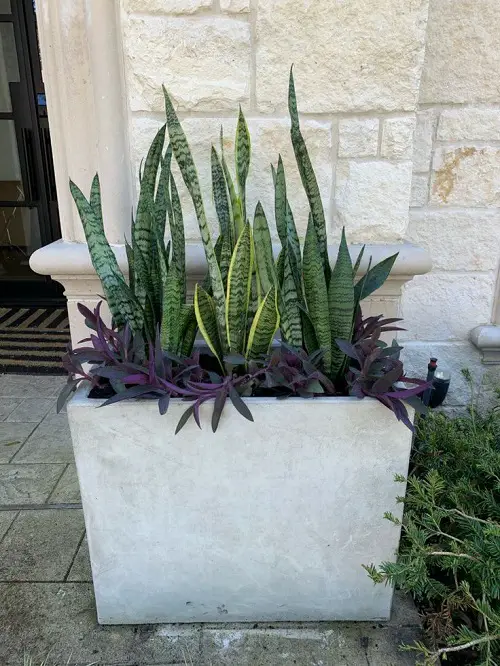
Concrete pots are another option you can go with. These pots have excellent insulation and help regulate the temperature of the soil for your plants. It goes without saying, but they’re extremely durable.
They’ll stand tall no matter the weather and are perfect if you’re growing a snake plant outdoors. But pick a good place for your plant because they’re heavy, and you won’t be able to move them without help.
Now that you know everything about snake plant pots, from the material, watering, sizes, and needs – we’re sure you’ll find the best one for your plant.


